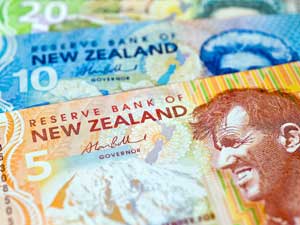New Zealand Currency Live Real-Time Daily and Historical Chart (Line, Candlestick, Bar, P&F)
Live Real-Time streaming chart of New Zealand Currency with adjustable line type, time frame/period, and optional technical indicators is available here.
One Month/ Hourly Bar
New Zealand Currency for Last Month
12 months/ Daily Line
New Zealand Currency for Last 12 Months
5 Years/ Weekly Candle
New Zealand Currency for Last 5 Years
Help - How to Use?
Read About How to Use Chart Module
Real-time streaming chart (New Zealand Currency) can be customized. You can change the time period (1 minute, 10 minute, 1 hour, 1 day or 1 week), time frame (from 10 to 500 time periods), chart type (bar, candle, line, P&F) or change/add technical indicator (Volume, RSI, MACD, Stohastic, Momentum and others); just move your mouse over the chart and notice the Options button in the right top corner of the chart. Click on this button and then adapt the settings according to your needs in the drop menu. You can also Detach the chart in a separate window and zoom it or even make it full-screen.
Do you find this content useful? Like! Tweet! Recommend! Share!
Facts Related to the New Zealand Currency
The New Zealand dollar is the official currency of New Zealand and is represented by the symbol $ or NZ$. It is coded as the NZD in the forex market and is commonly referred to by its nickname, the 'kiwi' courtesy of the world renowned ethnic and unique habitant of this island country. It is the Reserve Bank of New Zealand which is responsible for issuing the bank notes and coins of this currency in different denominations and while the bank notes are preceded by the prefix of the $ symbol the value of the coin is followed by the suffix 'c' which denotes cent. While 1 NZD is equal to 100 cents, all the bank notes are designed as being polymer notes laced with a number of security features as a counter measure against counterfeiting.
History of the New Zealand Currency
The New Zealand dollar was introduced as a replacement of the New Zealand pound which had been in existence since 1933, on 10th July, 1967. This course of action was motivated by the adoption of the dollar currency by South Africa and Australia and the name dollar was chosen over the pound due to its namesake, the US dollar. From the time of its introduction, the New Zealand bank notes and coins have been noteworthy in their characteristics in the sense that the bank notes traditionally featured the portrait of the Queen till as recently as 1992 which was subsequently replaced by the picture of the kiwi bird, landscape and a notable New Zealander. Likewise, historically the New Zealand coinage is the only one in the world to feature the abbreviation IRB under the Queen's head and have the smallest denomination in the world still in circulation.
Inflation/Deflation Trends Pertaining to the New Zealand Dollar
Having been a fiat currency for a long time the New Zealand dollar is prone to inflationary pressures which might last for a long time and may even aggravate with the passage of time. The introduction of the New Zealand dollar warranted its automatic inclusion in the Bretton Woods system due to which the currency suffered a major devaluation only to change its fixed foreign exchange to a moving peg against the dollar subsequent to the breakdown and abolishment of the system. In the following years, this currency was floated in the international markets and although its value has been traditionally determined by the value of the US dollar, the increased global participation in the forex market has caused its value to fluctuate in accordance with the currency trading.
Reserve Bank of New Zealand
The Reserve Bank of New Zealand is the sole issuing authority of the New Zealand currency and subsequent to having been established on 1st August, 1934, it issued the first bank note of the currency in form of the New Zealand pound. Although the primary function of this bank is to maintain stability in the price levels, controlling the issuing of currency and replacing money that might have been over used or damaged during circulation is also one of its few main responsibilities. It is the duty of the bank to accept all form s of the New Zealand dollar for payment at face value and this rule is applicable for a torn bank note which is more than half its original size as well. This bank is the supervisory authority of the over all banking system in New Zealand and is meant to ensure the sound economic health of the country.
New Zealand Dollar and its Related Factors

New Zealand holding the honor of being the least corrupt country in the world, the value of the New Zealand dollar in the contemporary era is affected by factors like industrial production, agriculture, exports, imports, electricity and oil trade. There was a time during the first half of the twentieth century when New Zealand had a protected and regulated economy and therefore the value of its currency remained stable and immune to global fluctuations. However, this situation altered during the second half of the twentieth century when the terms of trade declined significantly thus having an adverse affect on the value of the currency as well. Subsequent reforms and liberalization helped the New Zealand dollar to regain some of its lost value which is now being maintained through trade with countries like Australia and China.
Cross Rate Effect
Due to certain reforms which have been recently introduced by the Reserve Bank of New Zealand, there has been a record rise in the value of the New Zealand currency against the US dollar and this has landed the Kiwi in its strongest position against the dollar since 1985. Like its Australian counterpart, the New Zealand dollar is considered as being perfect for carry trade which means that the appreciation in the currency would not only affect the usual pair NZD/USD but also the pair of NZD/JPY which has steadily acquired the position of the most heavily traded currency pair during the recent months.
New Zealand Dollar and Forex Trading
The New Zealand currency along with its Australian counterpart is enjoying an all time high in the forex trading market against the US dollar owing to the increase in the rate of interest by the Reserve bank of New Zealand. This has caused a surge in the value of the currency pair NZD/USD thus providing the forex traders who have invested in this currency sizeable profits. A similar surge has been witnessed in the movement of the currency pair NZD/JPY as well therefore providing the forex traders with an opportunity to make up for all the losses which they might have incurred on this pair initially. The New Zealand dollar is the 12th most traded currency in the forex market due to its highly sensitive and volatile nature it is susceptible to even the slightest change in the trend of the market.
The financial market in New Zealand has been undergoing liberalization since 1984 and this has resulted in the free floating of exchange rates and removal of controls from interest rates, prices and wages. These measures resulted in a positive outcome in the value of the New Zealand dollar thus rating the nation as being the second most business friendly nation in the world. However, a slowdown in economic growth in the last decade of the twentieth century caused the value of the currency to fall only to be followed by a spur in exports and resuming of growth at the turn of the century. Although Australia has been the largest trading partner of this country, New Zealand encourages foreign investment without any kind of discrimination and this has proved to be a contributing factor in its economic growth. As of today, the only major concern which can negatively influence the value of the New Zealand dollar is the rising unemployment which is explained as being the fall out of global financial crisis.
Real-Time Quotes and Charts Navigator
Are you interested in real-time streaming charts for other indices, stocks, currencies, commodities and other asset classes? Just click on the available links within each asset class...
Select From Real-Time Quotes & Charts Navigator
U.S. Indices: Dow Jones | S&P 500 | Nasdaq 100 | Nasdaq Composite
Europe Indices: Euro Stoxx 50 | FTSE 100 | DAX 30 | CAC 40
Asia Indices: Nikkei 225 | Hang Seng | KOSPI
Currencies: EUR/USD | GBP/USD | USD/CHF | USD/CAD | AUD/USD | NZD/USD
Commodities: Gold | Silver | Light Crude | Brent Crude
Overviews: Custom Stocks Chart | Intraday Overview | Historical Overview | FX Majors
Do you find this content useful? Like! Tweet! Recommend! Share!
Related Articles
Where to Invest Money? Now, Today, 2011, Safely, Great Returns?
Would you like to know where to invest money? Find fresh stock research, analysis and strategies, plus latest news, discussions and experts' opinions.
ETF Trading Strategies Revealed - Fresh Signals and Ideas Daily
If you are looking for ETF trading strategies, this is the place to be. We provide investing ideas for the most popular ETFs in different categories.
Written by: Goran Dolenc
Back from New Zealand Currency to Stock Market Today
Back from New Zealand Currency to Best Online Trading Site Home Page










